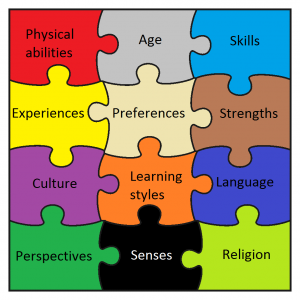e-Learning Ecologies MOOC’s Updates
Differentiated Learning Strategies: More Work for the Instructor or Redistribution of the Instructional Burden?
Differentiated learning implies that there are many different kinds of learners and that students learn in different ways. Difference can be related to learning styles as well as other factors that inform the learning context such as the learner’s class, ethnicity, or age background. Differentiated learning is an e-learning affordance because these differences now can better be accommodated in the digital classroom. Differentiated learning can happen simultaneously—with new educational media, students can be working on different things at the same time (Cope and Kalantzis 40). Two interrelated pedagogical design strategies that can be used to further differentiated learning objectives are the learning center and choice activities. They can be used to not just accommodate different learning styles through different modalities, but to reach different learners through epistemological diversity as well. Ultimately, we can harness these epistemological and experiential or sensory differences in order to enhance learning for the class as a whole.
One strategy is a learning center: a station with a cluster of materials that present the same information in a variety of different ways (Cox). For me as a college instructor, this can mean a digital learning module where I include readings, videos, and images on the same concept I want to teach my students. This is a way to accommodate visual, textual and auditory learners, but also to provide an epistemological variety where a variety of different perspectives and voices are represented.
By epistemological variety I mean I can include academic sources as well as more informal web sources like blogs in addition to films, videos, and other multimedia content. To reach every student and make the content relatable to them, I curate the sources so that a variety of different voices and experiences are represented: male, female, young, old, marginal groups, etc. I know this doesn’t work the same in every subject scenario, but I think some of these principles can be applied to most disciplines in one way or another. One tool to help teachers plan differentiated learning for their students’ needs is the Teaching Perspectives Inventory, assisting teachers evaluate their own teaching style, perspectives, and outcomes.
Secondly, choice activities refer to giving students the options about what they want to learn, which is a proven way to improve student motivation based on their own needs (Cox). Giving a lot of choice can produce chaos for the instructor, but this doesn’t have to be the case. In fact, having different students work on different things can even alleviate some of the burden on the instructor. One way to do this is to group students into thematic clusters based on their interests, so that each group approaches a specific topic based on what motivates them. These groups research as a cluster then share with the class. The instructor can curate the possible themes ahead of time on online group discussion boards, thinking ahead on how the different groups’ work will help advance the learning objectives of the course. Instead of having to prepare a lecture, the instructor can use the knowledge produced from these groups as the basis for the lesson, drawing on the discussion board entries and guiding the in-class discussion in the direction the instructor wants it to go.
Perhaps another way to look at differentiated learning is through the lens of Empowering Pedagogy, a concept coined by Northeastern University’s Design for Diversity Learning Toolkit. Empowering Pedagogy is “the collective term for pedagogical approaches and practices that educators use to design learning experiences that are active, engaging, and encourage learner inquisitiveness, choice, and self-direction… [and] include self-reflection by learners to critical, social justice, and decolonizing pedagogies” (Janicke Hinchecliffe). There are many was to produce differentiated learning, both epistemologically and experientially speaking. Usually they require the instructor to be comfortable with relinquishing some control, which if planned well from a backwards design perspective, can benefit everyone including the instructor. Implementing these choice-driven strategies require a bit more planning time from the instructor in designing assignments, but assignment prompts are reusable. Empowering students to take the lead based on their interests, backgrounds, and abilities can also redistribute the instructional burden, resulting in saved prep time and richer, more diverse classroom experiences.
Works Referenced
Cope, Bill and Mary Kalantzis. 2016. "Conceptualizing New Learning." In Cope, Bill and Mary Kalantzis, e-Learning Ecologies. Routledge NY, forthcoming.
Cox, Janelle. “Implementing Differentiated Instruction Strategies.” Teach Hub. https://www.teachhub.com/top-ways-implement-differentiated-instruction-strategies
Janicke Hinchcliffe, Lisa. “Empowering Pedagogy.” The Design for Diversity Learning Toolkit. Northeastern University Library. https://des4div.library.northeastern.edu/orientations/empowering-pedagogy/
Stefano, Michelle. “Diversity Puzzle.” Insider FIU Online. 5 Nov. 2019. https://insider.fiu.edu/teaching-diverse-learners/diversitypuzzle/
Teaching Perspectives Inventory. http://www.teachingperspectives.com/tpi/



I have never heard about the Teaching Perspectives Inventory and I will definitively look up about it. Thanks for you update and share of teaching experience !
Nice update!